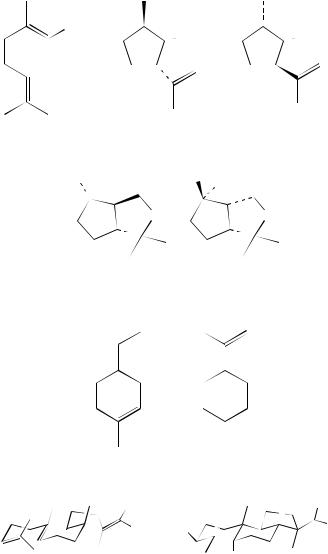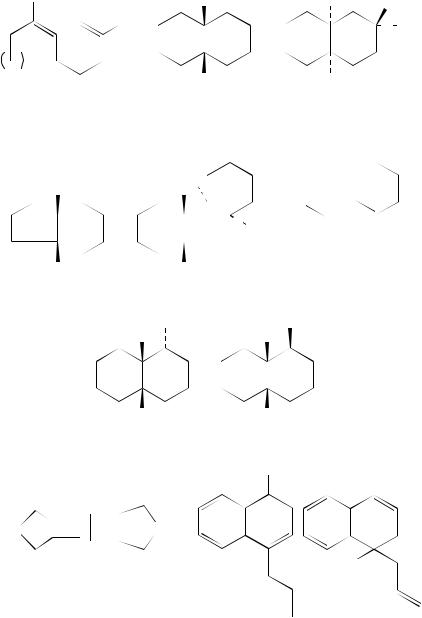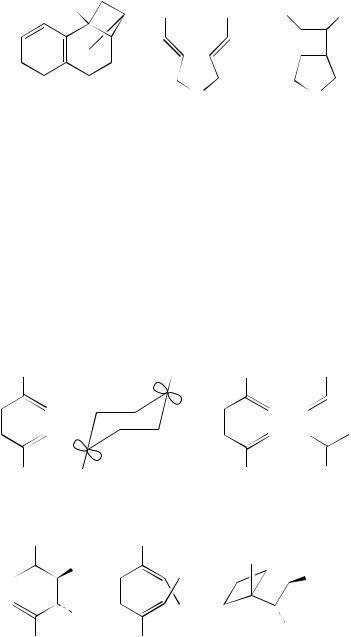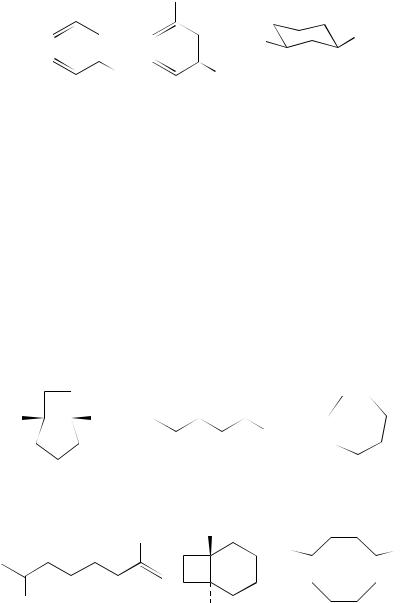

The Chemistry of Dienes and Polyenes. Volume 2
Edited by Zvi Rappoport
Copyright 2000 John Wiley & Sons, Ltd.
ISBN: 0-471-72054-2
CHAPTER 4
Photochemistry of non-conjugated dienes
WILLIAM M. HORSPOOL
Department of Chemistry, The University of Dundee, Dundee DD1 4HN, Scotland, UK
Fax: 44 (0)1382 345517; e-mail: w.m.horspool@dundee.ac.uk
I. INTRODUCTION . . . . . . . . . . . . . . . . . . . . . . . . . . . . . . . . . . . . . . |
258 |
|
II. ELECTRON TRANSFER REACTIONS . . . . . . . . . . . . . . . . . . . . . . . |
258 |
|
A. Acyclic and Cyclic Dienes . . . . . . . . . . . . . . . . . . . . . . . . . . . . . . |
258 |
|
B. Norbornadienes and Related Systems . . . . . . . . . . . . . . . . . . . . . . . |
268 |
|
III. CYCLOBUTANE FORMATION . . . . . . . . . . . . . . . . . . . . . . . . . . . . |
270 |
|
A. Copper(I) Triflate Controlled Reactions . . . . . . . . . . . . . . . . . . . . . . |
270 |
|
B. Cyclophane Syntheses . . . . . . . . . . . . . . . . . . . . . . . . . . . . . . . . . |
273 |
|
C. Other Cycloadditions . . . . . . . . . . . . . . . . . . . . . . . . . . . . . . . . . . |
278 |
|
1. |
Open-chain systems . . . . . . . . . . . . . . . . . . . . . . . . . . . . . . . . . |
278 |
2. |
Bicyclo[2.1.0]pentane systems . . . . . . . . . . . . . . . . . . . . . . . . . . |
282 |
3. |
Cubanes and related compounds . . . . . . . . . . . . . . . . . . . . . . . . |
282 |
4. |
Hexacyclotetradecane systems . . . . . . . . . . . . . . . . . . . . . . . . . . |
283 |
5. |
Pagodanes and related molecules . . . . . . . . . . . . . . . . . . . . . . . . |
285 |
6. |
Peristylane and related molecules . . . . . . . . . . . . . . . . . . . . . . . . |
286 |
7. |
Miscellaneous cycloadditions . . . . . . . . . . . . . . . . . . . . . . . . . . . |
288 |
IV. CYCLIZATION OF NORBORNADIENES AND RELATED |
|
|
COMPOUNDS . . . . . . . . . . . . . . . . . . . . . . . . . . . . . . . . . . . . . . . . |
290 |
|
A. All Carbon Systems . . . . . . . . . . . . . . . . . . . . . . . . . . . . . . . . . . . |
290 |
|
B. Hetero Norbornadiene Systems . . . . . . . . . . . . . . . . . . . . . . . . . . . |
295 |
|
C. Prismanes . . . . . . . . . . . . . . . . . . . . . . . . . . . . . . . . . . . . . . . . . |
296 |
|
V. DI- -METHANE PROCESSES . . . . . . . . . . . . . . . . . . . . . . . . . . . . . |
298 |
|
A. Open-chain Systems . . . . . . . . . . . . . . . . . . . . . . . . . . . . . . . . . . |
298 |
|
B. Cyclic Systems . . . . . . . . . . . . . . . . . . . . . . . . . . . . . . . . . . . . . . |
302 |
|
1. |
Benzotrienes . . . . . . . . . . . . . . . . . . . . . . . . . . . . . . . . . . . . . |
302 |
2. |
Benzonorbornadienes . . . . . . . . . . . . . . . . . . . . . . . . . . . . . . . . |
303 |
3. |
Bicyclo[2.2.2]octadienes . . . . . . . . . . . . . . . . . . . . . . . . . . . . . . |
303 |
4. |
Benzobarrelenes . . . . . . . . . . . . . . . . . . . . . . . . . . . . . . . . . . . |
306 |
257

258 |
William M. Horspool |
|
5. |
Dibenzobarrelenes . . . . . . . . . . . . . . . . . . . . . . . . . . . . . . . . . . |
308 |
|
a. Phase effects . . . . . . . . . . . . . . . . . . . . . . . . . . . . . . . . . . . . |
313 |
6. |
Other systems undergoing the di- -methane rearrangement . . . . . . . |
317 |
|
a. All-carbon systems . . . . . . . . . . . . . . . . . . . . . . . . . . . . . . . . |
317 |
|
b. Hetero-di- -methane systems . . . . . . . . . . . . . . . . . . . . . . . . . |
319 |
|
c. Triphenylmethyl derivatives . . . . . . . . . . . . . . . . . . . . . . . . . . |
320 |
VI. REFERENCES . . . . . . . . . . . . . . . . . . . . . . . . . . . . . . . . . . . . . . . . |
323 |
|
I. INTRODUCTION
Photochemistry in the area of non-conjugated dienes has burgeoned over the past decade or so and many topics of interest appear under this general heading. Obviously, such a chapter cannot be encyclopaedic and therefore some selection of areas to be covered has been made. In addition, a choice has been made in the time covered. The general area of diene photochemistry under review here has been of interest practically since the re-awakening of interest in organic photochemistry. Thus there is at least forty years of modern study. An excellent compendium was published more than thirty years ago by Schonberg¨1. This dealt with photochemical reactions in general but includes many examples related to the non-conjugated dienes. The subject matter is also covered to some extent in most of the standard texts dealing with organic photochemistry2 and also in specialized texts3. In the last thirty years there have also been useful annual compendia of photochemical results and advances and these have provided an extensive source of references4. In addition, there are some general reviews from the earlier periods which are also of value5,6.
II.ELECTRON TRANSFER REACTIONS
A.Acyclic and Cyclic Dienes
There are a variety of photochemical reactions that non-conjugated dienes can undergo. One of these that is currently of considerable interest is the reactivity brought about by electron-accepting sensitizers such as the cyanoarenes. The photoreactivity of these systems involves the photochemical excitation of the sensitizer to an excited state7. Thereafter, the reactivity is dependent on the ease of oxidation of the alkene or diene. With the transfer of an electron from the diene to the photoexcited sensitizer a radical cation is formed. It is this intermediate that brings about the various processes which occur within the diene systems under investigation.
There are many examples of such reactivity and some of these have been reviewed by Roth and coworkers8, a research group that is extremely active in this area. An example that is typical of the processes encountered involves the cyclization of the diene geraniol
(1). In this case the sensitizer is 9,10-dicyanoanthracene (DCA) and the reactions are carried out in methylene chloride. The authors9 state that a contact radical-ion pair is involved, i.e. the radical cation of the diene is in close proximity to the radical anion of the DCA. Reaction within this yields the cyclopentane derivatives 2 and 3 in the yields shown. The ring formation is the result of a five centre CC cyclization within the radical cation of 1. When a more powerful oxidant such as p-dicyanobenzene is used as the sensitizer in acetonitrile as solvent, separated radical-ion pairs are involved. This leads to intramolecular trapping and the formation of the bicyclic ethers 4 and 59. The bicyclic ether incorporates an aryl group by reaction of the radical cation of the diene with the radical anion of the sensitizer (DCB). This type of reactivity is referred to later. Other naturally occurring compounds such as (R)-(C)-˛-terpineol (6) and (R)-(C)-limonene (7)

4. Photochemistry of non-conjugated dienes |
259 |
can also be converted into the corresponding radical cations using p-dicyanobenzene (DCB) as the electron-accepting sensitizer10. Cyclizations can also be brought about with tetraenes such as 8 under SET conditions in aqueous acetonitrile solution. A variety of electron-accepting sensitizers was used but 1,4-dicyano-2,3,5,6-tetramethylbenzene was found to be especially effective. The radical cation formed from 8 undergoes a cascade cyclization to yield the product 911.
CH2OH |
CH2OH |
CH2OH |
|
70% |
|
6% |
(1) |
(2) |
|
(3) |
|
Me |
Ar |
Me |
|
|
|
|
|
O |
|
O |
|
(4) |
|
(5) |
|
Ar = p-NCC6H4 |
||
 OH
OH
(6) |
(7) |
CN |
CN |
CN HO |
CN |
|
H H |
(8) |
(9) |

260 |
William M. Horspool |
The radical cations of diene systems in cyclic molecules are also capable of reaction as demonstrated by Demuth, Roth and their coworkers12. They have studied the influence of phase on the photochemical reactivity of some naturally occurring dienes. Thus the irradiation of the diene 10 in homogeneous solution (acetonitrile/water) in the presence of an electron-accepting sensitizer such as cyanonaphthalene (CN) or DCB brings about trans,cis-isomerization only. However, when the electron transfer reaction is carried out in the presence of sodium dodecyl sulphate, transannular hydrogen abstraction reactions yield the two products 11 and 12. Similar reactivity is observed with trans-geranyl acetate 13 and all-trans-farnesyl acetate 14. The authors12 report that these cyclizations are the first examples of biomimetic processes brought about under SET conditions.
|
|
Me |
OH |
Me |
OH |
|
|
H |
|
H |
|
H |
H |
HMe |
|
HMe |
|
|
(10) |
(11) |
|
(12) |
|
CH2OAc
OAc
(13) |
(14) |
In some instances the intermediate radical cations formed from non-conjugated dienes undergo addition to the cyanoarene sensitizer. Such reactions involve the replacement of a cyano group on the arene by the diene moiety. These reactions have been termed photo-NOCAS (photochemical Nucleophile –olefin combination, Aromatic substitution) processes. Such behaviour is observed with the 2,6-dimethylhepta-1,6-diene 15. When this is irradiated in methanol solution under electron-transfer conditions with DCB as the electron-accepting sensitizer and biphenyl as the co-sensitizer, the products (obtained in low yields) formed from this treatment are shown in Scheme 1. In this there are three distinct reaction types, each involving combination between the diene, MeOH and the sensitizer. These reaction types are addition of MeOH to the open chain system, cyclization to a cyclohexane product and cyclization to a cycloheptane13. Considerable effort has been expended on the study of the photo-NOCAS processes and Arnold and his coworkers have supplied details of the factors that control the regiochemistry14. As can be seen, reaction with an alkene moiety is quite common and is also illustrated for the diene 16. In this molecule cyclization of the radical cation is unlikely and all the reactions

4. Photochemistry of non-conjugated dienes |
261 |
|
CN |
Me |
|
+
CN |
|
|
|
Me |
|
|
|
(15) |
|
|
|
biphenyl |
|
hν, MeOH − MeCN |
|
||
|
|
||||
Me |
Me |
|
OMe |
Me |
OMe |
|
|||||
Ar |
|
|
|
||
OMe |
|
|
|
|
|
+ |
|
|
Ar |
+ |
|
|
|
|
|
|
|
|
|
|
Me |
|
Ar |
Me |
|
|
|
Me |
|
|
|
|
|
||
5% |
12% cis |
|
12% cis |
||
|
11% trans |
|
10% trans |
||
|
Ar = 4−cyanophenyl |
|
|
||
SCHEME 1
encountered involve addition to an alkene group. The reaction is again carried out in methanol with DCB as the sensitizer and biphenyl as the co-sensitizer. This treatment gives low yields of 17 and 18 by trapping of the radical cation of the diene 16 by methanol15. In acetonitrile as solvent, many products are formed such as 19 and 20 by reaction with the solvent acetonitrile or the sensitizer, respectively.
CN
OMe
MeO
(16) |
(17) |
3% |
(18) |
20% |

262 |
|
|
|
|
William M. Horspool |
||
|
|
|
|
Me |
|||
N |
|
|
|
|
O |
|
CN |
|
|
|
|
|
|||
|
|
|
|
|
|||
|
|
|
|
|
|
|
|
|
|
||||||
|
|
|
|
|
|
|
|
|
|
|
|
|
|
|
|
(19) 2% |
(20) 2% |
The synthetic application of SET processes is also of considerable interest since viable synthetic routes to a variety of molecules can be devised. For example, Heidbreder and Mattay16 have shown that silyl derivatives of enols can undergo cyclization following radical cation formation. Irradiation at 450 nm of 21 in acetonitrile using DCA as the electron-accepting sensitizer ultimately brings about the formation of bicyclic compounds 22. The process involves cyclization within the radical cation 23. Several other examples of this type of cyclization have been reported, again using the same reaction conditions. This has helped to demonstrate the scope of the process. Thus the parent system 24, R D H, affords the cyclic ketone 25 in 25% yield. The effect of chain length and substituents on the reaction has also been evaluated. Thus 24, R D Me, is converted into the mixture of isomers 26 while 27 affords 28. Tricyclic products such as 29 can also be obtained in moderate yields from the cyclization of 30. The basic reaction of 24 is solvent-sensitive. This is demonstrated by the formation of three products when the reaction is carried out in acetonitrile/propan-2-ol. These were identified as the original product (25, 30%) and two minor products 31 formed in 11% and 32 formed in 9%17.
|
SiMe3 R |
O |
R |
|
SiMe3 |
R |
||
|
|
|
|
|
|
|
|
|
O |
|
|
|
O |
|
|||
|
R |
|
|
|
|
+ |
|
R |
|
|
|
|
|
R |
• |
|
|
|
|
|
|
|
|
|
|
|
CO2Et |
EtO2C |
|
CO2Et |
|
||||
(21) (a) R = H |
(22) (a) 24% |
|
(23) |
|
||||
(b) R = Me |
|
|
(b) 59% |
|
|
|
|
|
The presence of hetero-atoms within the system, remote from the alkene double bonds, does not have an adverse influence on the SET processes that occur. Thus irradiation of the diene 33 in benzene solution with 1,4-dicyanonaphthalene as the electron-transfer sensitizer affords the cyclobutane 34 in 78% yield. Various examples of the reaction were described giving cyclobutane derivatives in 54 – 69% yield. Benzene, or an arene solvent, is vital for the success of the reaction. When acetonitrile is used, allylation of the sensitizer (akin to the photo-NOCAS reaction) results in the formation of the three products 35–3718. (2 C 2)-Cyclization of this type described for 33 is also seen with the dialkenyl ether 38. When 38 is irradiated using > 350 nm or > 450 nm in acetonitrile

|
|
4. Photochemistry of non-conjugated dienes |
|
|
263 |
|||||||||||||||
OSiMe3 |
|
|
|
O |
O |
|
|
|
|
|||||||||||
|
|
|
|
|
H |
|
|
|
H |
|
|
R1 |
||||||||
|
|
|
|
R |
|
|
|
|
|
|
|
|
|
|
|
|
|
|
|
R2 |
|
|
|
|
|
|
|
|
|
|
|
|
|
|
|
||||||
n |
|
|
|
|
|
H |
|
|
|
H |
|
|
|
|
||||||
|
|
|
|
|
|
|
|
|
|
|
|
|
|
|
|
|
||||
(24) n = 2 |
|
|
|
(25) |
|
|
(26) R1 |
R2 |
|
|
||||||||||
(27) n = 1, R = H |
|
|
|
|
|
|
|
|
|
|
|
Me |
H |
|
9% |
|||||
|
|
|
|
|
|
|
|
|
|
|
|
|
|
|
|
H |
Me |
|
11% |
|
O |
O |
|
|
H |
OSiMe3 |
|
|
|
|
|||||||||||
|
|
H |
|
|
|
|
H |
|
|
|
|
|
|
|
|
|||||
|
|
|
|
|
|
|
|
|
|
|
|
|
H |
|
|
|
|
|||
|
|
|
|
|
|
|
|
|
|
|
|
|
|
|
|
|
||||
|
|
H |
|
|
|
|
H |
|
|
|
|
|
|
|
|
|||||
(28) |
|
|
|
|
|
(29) |
|
|
(30) |
|
|
|
|
|||||||
|
|
O |
|
Me |
|
|
O |
Me |
|
|
|
|
||||||||
|
|
|
|
H |
|
|
|
|
|
|
|
|
H |
|
|
|
|
|||
|
|
|
|
|
|
|
|
|
|
|
|
|
|
|
|
|
|
|
|
|
|
|
|
|
H |
|
H |
|
|
|
(31) |
(32) |
|
|
||||
|
|
|
|
|
|
CN |
|
CN |
|
|
|
|
|
|
|
|
|
Me2Si |
|
|
|
|
SiMe2 |
|
|
|
|
|
|
|
|
|
|
||
|
|
|
|
|
CN |
|||
|
|
|
|
|
|
|
||
|
|
|
|
|
|
|
||
(33) |
(34) |
(35) |
|
|
||||
(36) |
||||||||
|
|
|
|
|
|
|
|
|
solution with tetracyanoethylene as the electron-accepting sensitizer, the product 39 is obtained. Again a radical cation cyclization is proposed to account for this19.

264 |
|
William M. Horspool |
|
|
|
|
CN |
Ar |
Ar |
Ar |
Ar |
|
|
||||
|
CN |
O |
O |
|
|
|
|
(37) |
|
(38) |
(39) |
Ar = 4-MeOC6H4
A study of the photochemical Cope reaction of the hexadienes 40 has been carried out under photoinduced electron-transfer conditions. Evidence was gathered for the formation of a chair cyclohexane-1,4-radical cation 4120. In such systems, where the radical cation is formed using DCA as the sensitizer, a degenerate Cope process is operative. Thus when the tetradeuterio derivative 42 is used, rearrangement affords a (52 : 48) mixture of the two dienes 42 and 4321. Related to this general problem, DCA-sensitized reactions of the isomeric dienes 44 and E,E-45 and the cyclization product, the bicyclohexane 46, have been studied in considerable detail22. At low conversions, the irradiation of 46 affords a mixture of the dienes 44 and E,E-45 in ratios that are independent of temperature. The influence of the position of the aryl groups on the diene skeleton has also been studied. This does not appear to affect the conversion to a cyclic radical cation. Thus the SETinduced reaction of the diene 47 has shown that the open chain radical cation of the diene 48 cyclizes preferentially to the radical cation 4923.
Ar |
|
Ar |
Ar |
|
Ar |
|
|
+ |
D2 |
|
|
|
|
|
|
D2 |
|
|
|
|
D2 |
|
D2 |
|
|
• |
|
|
|
Ar |
Ar |
|
Ar |
|
Ar |
(40) |
|
(41) |
(42) |
(43) |
|
|
|
Ar = p-MeOC6H4 |
|
|
Ar = 4-XC6H4 |
|
|
|
|
|
X = OMe, Me, Cl |
Ar |
|
Ar |
|
Ar |
|
|
Me |
|
Ar |
|
|
|
Me |
|
|
Me |
|
|
|
|
|
||
|
|
|
|
|
|
|
Me |
Me |
|
|
|
|
|
|
|
|
|
|
|
|
|
|
Me |
Ar |
|
Ar |
|
|
|
(44) |
|
(45) |
|
(46) |
|
|
|
Ar = 4-MeOC6H4 |
|
|
|

4. Photochemistry of non-conjugated dienes |
265 |
|||
Ph |
Ph |
|
|
|
|
|
|
|
|
|
+ • |
Ph |
|
Ph |
|
|
|
|
|
Ph |
|
Ph |
|
|
(47) |
(48) |
|
(49) = + or • |
|
Cyclization of the type that leads to the formation of 46 from 44 and 45 is also observed with a longer insulator between the two alkene components of the non-conjugated diene. Thus the cyclobutane derivatives 50 can be formed from the dienes 51. Again a radical cation 52 is formed from 51 using SET to DCA. This provides an efficient path to the bicyclic compounds 5024. Griesbeck and coworkers25 have also reported on the cyclization of 51. In addition, they have examined the reactions encountered with the dienes 53 where cyclization to the bicyclo[4.2.0]octane system 54 takes place via the radical cation. The cyclization in these molecules is not quite as efficient as in the previous examples. The head:head product, i.e. the cyclooctenes 55, are formed in competition with the other process. A further study of these cyclizations has examined the influence of solvent on the conversion of 56 into the two products 57 and 58. The mechanism proposed again utilizes a cyclic radical cation as intermediate and this has been substantiated by trapping experiments with oxygen26. Further study has examined the influence of an alkyl substituent on one of the double bonds of the dienes 59 and 60. Stereoselective intramolecular (2 C 2)-cycloadditions occurred on DCA sensitization, yielding the endo and exo bicycloheptanes 61 and 62, respectively. Although the reactions with the E-isomer 59 appeared not to be stereoselective, this effect was found to be time-dependent and shorter irradiation times gave better selectivity27.
Ar |
Ar |
|
|
|
|
|
|
|
|
Ar |
• |
+ |
Ar |
|
|
|
|
||||||||||
|
Ar |
|
|
|
|
Ar |
|
|
|
||||
(50) yield (%) |
(51) |
Ar = 4-MeOC6H4 |
(52) |
|
|
||||||||
53 |
|
|
|
|
|
Ar = 4-MeC6H4 |
|
|
|
||||
80 |
|
|
|
|
|
Ar = Ph |
|
|
|
||||
76 |
|
|
|
|
|
|
|
|
|
|
|
|
|
|
Ar |
Ar |
|
|
|
||||||||
|
|
|
|
|
Ar |
|
|
Ar |
|||||
|
|
|
|
|
|
|
|
|
|
|
|
||
Ar |
|
|
|
|
|
Ar |
|
|
|
||||
|
|
|
|
|
|
|
|
||||||
|
|
|
|
|
|
|
|
|
|||||
(53) |
|
|
|
|
(54) |
|
|
|
|
(55) |
|
|
|
Ar = Ph, p-MeC6H4, p-MeOC6H4 |
|
|
|
|
|
|
|
|
|||||

266 |
|
|
|
|
|
William M. Horspool |
|
|
|
|
||
|
|
|
|
|
|
|
|
|
|
|
|
Ar |
|
|
|
|
|
|
|
|
Ar |
|
|
|
|
Ar |
|
|
|
n |
|
Ar |
n |
|
|
|
|
|
|
|
|
|
|
|
|
||||||
|
|
|
|
|
|
|
|
|
||||
|
|
|
|
|
|
|
||||||
|
|
|
|
|
|
|
|
|
|
|
|
|
|
|
|
|
|
|
|
|
Ar |
|
|
n |
|
|
|
|
|
|
|
|
|
|
|
|
|
|
|
|
|
|
|
|
|
|
|
|
|
|
Ar |
|
(56) |
|
|
|
(57) |
|
|
(58) |
||||
n = 1 or 2, Ar = 4-MeOC6H4 or Ph |
n = 1 a |
|
yield (%) Solvent |
|||||||||
|
|
|
|
|
|
|
|
0 |
86 |
|
MeCN |
|
|
|
|
|
|
|
|
|
a |
65 |
31 |
|
C6H6 |
|
|
|
|
|
|
|
|
b |
58 |
24 |
|
MeCN |
|
|
|
|
|
|
|
|
n = 2 a |
0 |
9 |
|
MeCN |
|
|
|
|
|
|
|
|
|
||||
Ar |
(59) |
|
|
Ar |
b |
10 |
21 |
|
MeCN |
|||
|
|
|
|
Ar |
|
|
|
|
||||
|
|
(a) R = 4-MeOC6H4 |
|
|
|
|
|
|
||||
|
|
|
|
Ar |
|
Ar |
Ar |
|||||
(b) Ar = Ph
Ar |
Ar |
|
|
(62) |
|
(61) |
|
||
|
(60) |
61 |
62 |
|
|
Ea′ |
65 |
0 |
ratio endo: exo 0 |
|
Eb′ |
70 |
0 |
0 |
|
Za′ |
27 |
45 |
1 : 1.7 |
|
Zb′ |
32 |
34 |
1 : 1.7 |
Yoon and Chae28 have described the DCA-induced photochemical conversion of the cyclopentadiene derivatives 63 into several products. However, only the anti-Bredt adduct 64 is different from those obtained by thermal activation. The experimental data collected have implicated a triplex intermediate 65 in the formation of 64. This triplex is the result of interaction between the diene, the non-conjugated alkene component and the sensitizer. While a mixture of cyclopentadienes was used, it is likely that the products 64 are formed exclusively from the 2-isomer 66.
Ph
(CH2)n
Ph
 n−1
n−1
(63) |
(64) |
|
n = 2 or 3 |
n = 2 |
12% |
|
n = 3 |
13% |
